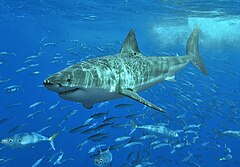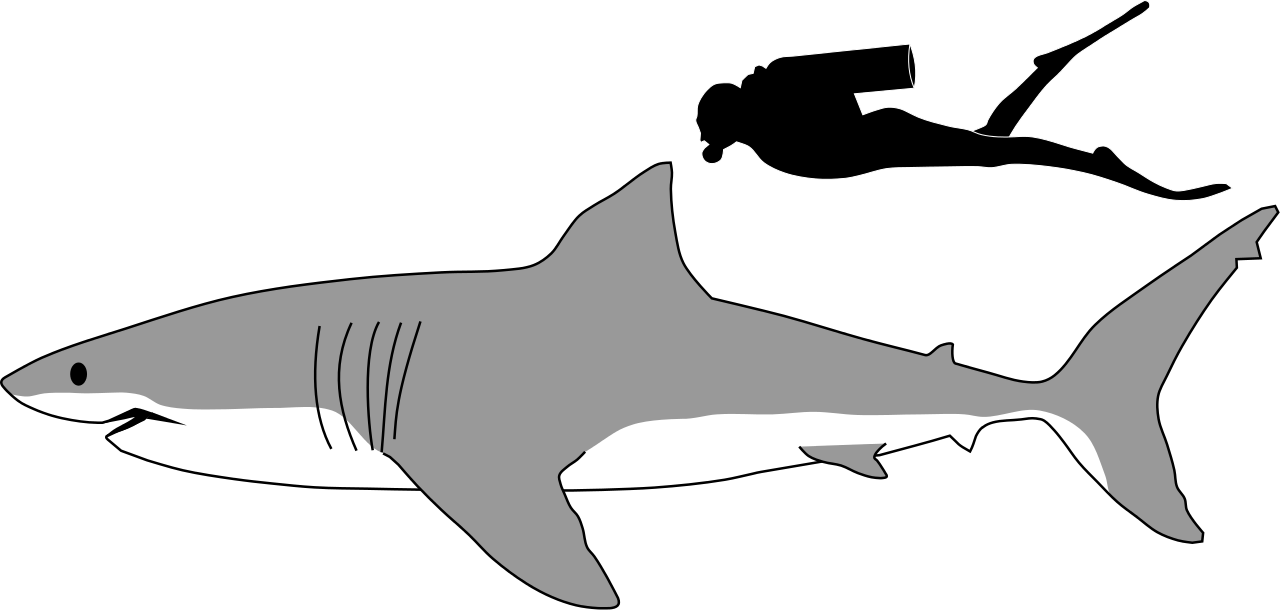 |
| The Great White Shark |
The Great White Shark (Carcharodon charcarias), as known as great white or white shark is a species of large mackerel shark that can be found in the coastal surface waters of all the major oceans. The great white shark is notable for its size, with larger female individuals growing to 6.1 m (20 ft) in length and 1,905 kg (4,200 lb) in weight at maturity. However, most are smaller; males measure 3.4 to 4.0 m (11 to 13 ft), and females measure 4.6 to 4.9 m (15 to 16 ft) on average. According to a 2014 study, the lifespan of great white sharks is estimated to be as long as 70 years or more, well above previous estimates, making it one of the longest-lived cartilaginous fish currently known. According to the same study, male great white sharks take 26 years to reach sexual maturity, while the females take 33 years to be ready to produce offspring. Great white sharks can swim at speeds of over 56 km/h (35 mph) and can swim to depths of 1,200 m (3,900 ft).
Here is the taxonomy of the great white shark.
| Kingdom: | Animalia |
| Phylum: | Chordata |
| Class: | Chondrichthyes |
| Order: | Lamniformes |
| Family: | Lamnidae |
| Genus: | Carcharodon |
| Species: |
C. Carcharias
|
The great white shark has no known natural predators other than, on very rare occasions, the killer whale. The great white shark is arguably the world's largest known extant macro predatory fish and is one of the primary predators of marine mammals. It is also known to prey upon a variety of other marine animals, including fish and seabirds. It is the only known surviving species of its genus Carcharodon and is responsible for more recorded human bite incidents than any other shark.
 |
|
The great white shark has a robust, large, conical snout. The upper and lower lobes on the tail fin are approximately the same size which is similar to some mackerel sharks. A great white displays countershading, by having a white underside and a grey dorsal area (sometimes in a brown or blue shade) that gives an overall mottled appearance. The coloration makes it difficult for prey to spot the shark because it breaks up the shark's outline when seen from the side. From above, the darker shade blends with the sea, and from below it exposes a minimal silhouette against the sunlight. Leucism is extremely rare in this species but has been documented in one great white shark (a pup that washed ashore in Australia and died). Great white sharks, like many other sharks, have rows of serrated teeth behind the main ones, ready to replace any that break off. When the shark bites, it shakes its head side-to-side, helping the teeth saw off large chunks of flesh. Great white sharks, like other mackerel sharks, have larger eyes than other shark species in proportion to their body size. The iris of the eye is a deep blue instead of black.


Komentar
Posting Komentar